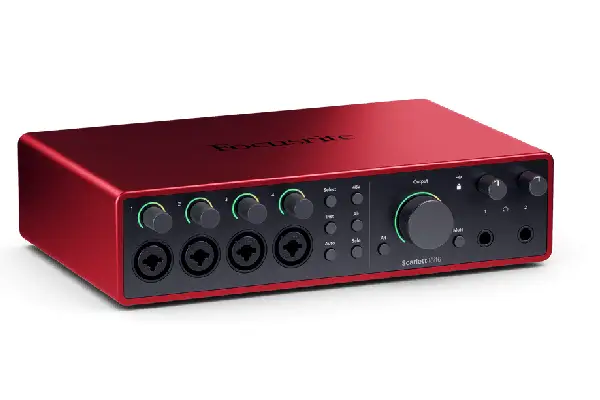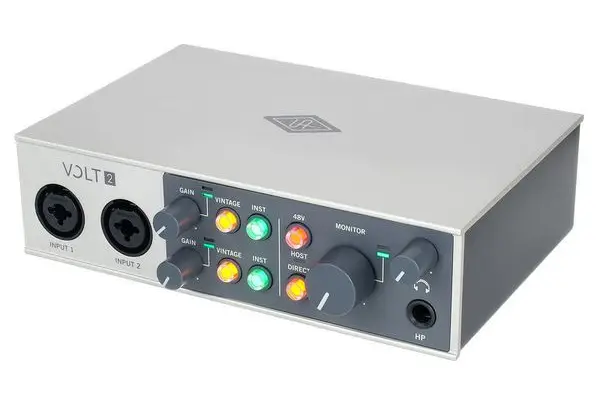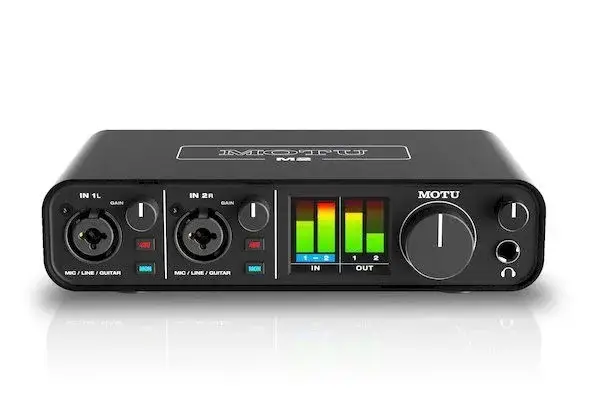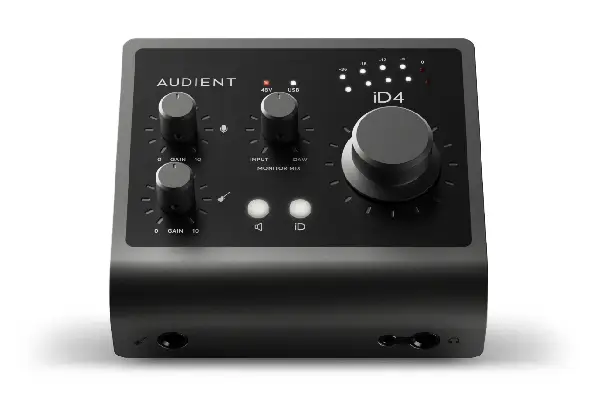The best audio interfaces for YouTube need to balance pristine preamp quality, reliable driver performance, and intuitive operation that doesn’t interrupt your creative workflow. Whether you’re recording voiceovers, capturing instrument performances, or managing podcast-style interviews, these five interfaces represent the sweet spot between professional capability and practical YouTube content creation.
| Model | Key Strengths | Pros | Cons |
|---|---|---|---|
| Focusrite Scarlett 2i2 (4th Gen) | Improved preamps, Air mode, durable metal build, great for YouTube creators | • Clear preamps with Air mode• Strong metal construction• Gain halos prevent clipping• Stable drivers• Auto Gain works well | • Only 2 inputs• Higher-end units sound cleaner• Bundled software can overwhelm beginners |
| Universal Audio Volt 2 | Vintage preamp warmth + built-in compressor, strong for voice character | • Vintage mode adds warmth• Onboard compression• Clean 48V phantom power• UA-quality converters• Zero-latency monitoring | • Vintage color not for everyone• Only 2 inputs• No MIDI ports |
| PreSonus AudioBox USB 96 | Great value, reliable plug-and-play performance, strong for beginners | • Excellent audio for the price• Works on many systems easily• Studio One Artist included• Compact size• Good headphone amp | • Plastic build• No onboard processing• Max 96kHz sample rate only |
| MOTU M2 | Professional-grade converters, LCD metering, ideal for detailed music content | • ESS Sabre32 converters• Excellent LCD meters• Great loopback feature• Premium aluminum build• Ultra-low latency | • No MIDI ports• Slightly more expensive• LCD could be brighter |
| Audient iD4 MKII | Console-level preamps, ScrollControl workflow feature, precision build | • Exceptional preamps• ScrollControl saves time in editing• Great JFET instrument input• Strong metal build• Powerful headphone amp | • Only one input• More pricey than basic 2-input models• Limited monitoring controls |
Focusrite Scarlett 2i2 (4th Generation)

The Scarlett 2i2 has essentially become the default recommendation for YouTube creators, and after using multiple generations extensively, I understand why this interface maintains its dominance. The fourth generation brings genuinely improved preamps with Focusrite’s Air mode—a feature that adds subtle high-frequency lift that makes voices pop without sounding artificially processed. What strikes me most about this interface is how forgiving it is during rushed recording sessions; the preamps handle everything from whisper-quiet ASMR narration to enthusiastic gaming commentary without breaking a sweat.
The build quality feels reassuringly solid, with metal construction that survives the chaos of a content creation desk better than plastic alternatives. I’ve knocked mine off the desk twice (don’t ask), and it continued functioning without issues. The gain halos around each input provide visual feedback that prevents the frustrating experience of discovering clipped audio after recording a perfect take. For YouTube work specifically, the direct monitoring with zero-latency is essential when you’re recording while watching your own footage for timing—something I do constantly when adding voiceover to detailed instrument demonstrations.
Pros:
- Exceptional preamp clarity with useful Air mode enhancement
- Bombproof metal construction that handles desktop accidents
- Intuitive gain halos prevent recording mistakes
- Rock-solid driver stability across all major platforms
- Auto Gain feature actually works well for voice recording
Cons:
- Only two inputs limit multi-mic podcast setups
- Higher-end interfaces offer noticeably cleaner preamps at significant price increases
- Bundled software may overwhelm beginners
Universal Audio Volt 2

Universal Audio’s entry into the affordable interface market surprised me with how much of their premium sound they managed to pack into this price point. The Volt 2’s vintage preamp mode introduces analog-style saturation that adds warmth and presence to vocal recordings—particularly effective for YouTube content where you want personality and character in your voice. I’ve found this especially valuable when recording music tutorial content, where the slightly colored sound makes explanations feel more engaging than clinically clean recordings.
What sets the Volt 2 apart during actual YouTube production is the built-in compressor on the front panel. Being able to dial in basic compression before hitting the computer means I spend less time fixing dynamics in post-production, which speeds up my workflow considerably. The compressor isn’t surgical-precision professional gear, but for YouTube content where you’re balancing quality against production speed, it hits exactly the right target. The interface also includes genuine 48V phantom power with solid implementation—my condenser mics receive clean, noise-free power without the hum issues I’ve experienced with cheaper units.
Build quality matches the Scarlett’s metal construction, though the Volt 2’s retro-inspired aesthetics either charm you immediately or feel slightly gimmicky. I’m in the charmed camp, particularly because the physical controls have satisfying resistance that prevents accidental adjustments. The direct monitoring mix knob is perfectly placed for quick adjustments during recording sessions when you’re managing multiple audio sources.
Pros:
- Vintage preamp mode adds character without overwhelming the signal
- Onboard compression reduces post-production workload
- Clean 48V phantom power for condenser microphones
- UA’s converter quality at an accessible price point
- Direct monitoring with excellent zero-latency performance
Cons:
- Vintage mode won’t appeal to creators wanting neutral sound
- Limited to two inputs like most competitors at this price
- No MIDI connectivity if you’re expanding into music production
PreSonus AudioBox USB 96

The AudioBox USB 96 occupies the budget category, but calling it a “budget interface” undersells how capable this unit actually performs for YouTube content. After using it extensively for a remote recording setup, I’m genuinely impressed by PreSonus’s focus on the fundamentals—the preamps are clean enough for professional-sounding narration, and the A/D converters exceed expectations at this price. Where you notice the cost savings is in features rather than core audio quality, which is exactly the right compromise for YouTube creators focused on voice and basic instrument recording.
What makes the AudioBox particularly YouTube-friendly is its plug-and-play reliability. I’ve connected it to everything from high-end Windows workstations to budget laptops running older operating systems, and it simply works without driver drama. For creators who record music comparisons or equipment reviews where you’re constantly connecting and disconnecting gear, this reliability becomes genuinely valuable. The interface also includes surprisingly decent headphone amplification that drives both consumer headphones and studio monitors with adequate volume and clarity.
The plastic housing definitely feels less premium than metal alternatives, and I wouldn’t recommend tossing this in a backpack for mobile recording without protection. However, it sits perfectly fine on a desk setup, and the blue LED indicators provide clear visual feedback during recording. PreSonus includes their Studio One Artist DAW, which offers more professional capabilities than the limited versions bundled with some competing interfaces.
Pros:
- Exceptional audio quality relative to modest price point
- Genuinely plug-and-play across multiple operating systems
- Included Studio One Artist provides real production capability
- Compact footprint fits crowded YouTube creator desks
- Surprisingly good headphone amplification
Cons:
- Plastic construction feels less durable than metal alternatives
- Basic feature set lacks onboard processing
- Only 96kHz maximum sample rate (though perfectly adequate for YouTube)
MOTU M2

The MOTU M2 represents a significant step up in converter and preamp quality, and the difference becomes immediately obvious when you’re recording detailed content like acoustic instrument demonstrations or high-fidelity music reviews. What initially attracted me to this interface was the exceptionally detailed metering—the full-color LCD screen displays precise input and output levels with professional accuracy that prevents the common YouTube creator mistake of recording too quietly or clipping peaks. After months of use, that metering has saved countless retakes by showing exactly what’s happening with my audio signal.
MOTU’s ESS Sabre32 Ultra converters deliver genuinely professional-grade conversion that rivals interfaces costing significantly more. When I’m recording content about audio gear or creating detailed song breakdowns, the M2 captures nuances that more affordable interfaces simply miss—subtle harmonic content, delicate high-frequency detail, and accurate low-end response. The loopback feature is brilliantly implemented for YouTube creators who need to capture computer audio alongside microphone input, something essential for gaming content, software tutorials, or reaction videos.
Build quality is outstanding with a full aluminum chassis that feels precision-engineered rather than mass-produced. The volume knob has perfect resistance with a smooth, professional feel that inspires confidence. My only minor complaint involves the lack of MIDI I/O, which limits the interface if you’re expanding into music production alongside YouTube content. However, for pure audio recording, the M2 punches well above its price category.
Pros:
- Professional-grade ESS Sabre32 converters exceed price expectations
- Detailed LCD metering prevents common recording mistakes
- Excellent loopback implementation for capturing computer audio
- Premium aluminum construction with outstanding build quality
- Ultra-low latency performance for real-time monitoring
Cons:
- No MIDI connectivity limits music production expansion
- Slightly higher price than competitor alternatives
- Metering screen brightness could be better in bright environments
Audient iD4 MKII

The Audient iD4 MKII brings genuine console-grade preamp technology to the YouTube creator space, and you can hear the difference immediately. Audient’s console heritage shows through in how these preamps handle dynamic range—they remain clean and detailed whether you’re recording quiet narration or enthusiastic commentary with significant volume variations. What I particularly appreciate during long recording sessions is how the iD4’s preamps maintain clarity without the ear fatigue that some overly bright interfaces can cause after hours of monitoring.
The standout feature for YouTube work is the ScrollControl function, which lets you use the main volume knob to adjust system volume or scroll through DAW parameters. This sounds like a minor convenience until you’re actually editing content and realize how often you’re reaching for volume controls—having it integrated into your audio interface streamlines the workflow beautifully. The JFET instrument input deserves special mention; it’s voiced specifically for guitar and bass with impedance characteristics that capture instrument tone accurately, making this interface particularly valuable if your YouTube content involves music performance or instrument reviews.
Build quality matches the professional aspirations with metal construction and controls that feel satisfyingly precise. The single combo XLR/TRS input might seem limiting, but Audient designed this interface specifically for solo creators, and that focus shows in the thoughtful feature implementation. The included software bundle provides genuinely useful tools rather than overwhelming beginners with dozens of mediocre plugins.
Pros:
- Console-grade preamps deliver exceptional clarity and detail
- ScrollControl function streamlines editing workflow
- Excellent JFET instrument input for guitar and bass recording
- Professional build quality with precise, satisfying controls
- Class-leading headphone amplifier drives demanding headphones easily
Cons:
- Single input limits recording flexibility
- Higher price point than basic two-input alternatives
- No onboard monitoring controls beyond volume
Frequently Asked Questions
Do I really need an audio interface for YouTube, or is a USB microphone sufficient?
USB microphones work perfectly fine for basic YouTube content, but dedicated audio interfaces provide significantly more flexibility and future-proofing for your channel. The key advantage comes from expandability—interfaces let you upgrade microphones, add multiple audio sources, and incorporate professional XLR equipment as your content evolves. I started with a USB microphone and hit limitations quickly when I wanted to record interviews or capture instrument performances alongside narration. Additionally, interface preamps generally offer cleaner amplification with lower noise floors than the preamps built into USB microphones, resulting in more professional-sounding content that helps your channel stand out.
What sample rate should I use when recording for YouTube?
YouTube converts everything to 48kHz regardless of your upload format, so recording at 48kHz/24-bit represents the ideal balance between quality and file size management. I’ve experimented extensively with higher sample rates (96kHz and beyond), and the difference becomes essentially imperceptible after YouTube’s compression and conversion process. Recording at 48kHz also reduces the processing load on your computer during editing, which matters more than you’d expect when you’re working with multiple audio tracks, effects, and video footage simultaneously. Save the higher sample rates for music production projects where you’re maintaining full resolution throughout the entire production chain.
Can I use these interfaces for live streaming as well as recorded content?
Absolutely—these interfaces work excellently for live streaming, with some offering specific advantages for streaming workflows. The loopback features on units like the MOTU M2 make capturing game audio or desktop sound alongside your microphone input incredibly straightforward. I regularly use my Scarlett 2i2 for streaming because the driver stability prevents the audio dropouts that can ruin live broadcasts. The direct monitoring with zero latency means you can hear yourself naturally without the delayed, echo-like effect that drives streamers crazy. Just ensure you configure your streaming software to recognize the interface correctly and set appropriate buffer sizes to balance latency against CPU usage.
How important is phantom power for YouTube recording?
Phantom power (48V) becomes essential if you’re using condenser microphones, which includes most popular YouTube microphones beyond basic dynamic mics. Condenser mics require phantom power to operate their internal electronics, and proper phantom power implementation matters more than many creators realize. I’ve used interfaces with noisy or unstable phantom power that introduced hum into recordings, forcing me to spend valuable editing time removing unwanted noise. All five interfaces I’ve recommended provide clean, reliable phantom power that won’t compromise your audio quality. If you’re currently using dynamic microphones like the Shure SM7B, you might not need phantom power immediately, but having that capability available provides flexibility for future microphone upgrades.
Should I prioritize more inputs or better preamp quality for YouTube content?
For most YouTube creators, better preamp quality delivers more tangible benefits than additional inputs. Excellent preamps capture cleaner audio with more detail and less noise, which translates directly into more professional-sounding content that helps your videos compete for viewer attention. I’ve found that most YouTube content relies on one or two audio sources maximum—your voice and occasionally a guest or instrument. The situations requiring more than two simultaneous inputs are relatively rare unless you’re creating specific types of content like band performances or complex podcast productions with multiple hosts. Focus on getting the best preamps you can afford for your primary one or two inputs, then expand to larger interfaces later if your content style genuinely requires additional channels.
Will these interfaces work with both Mac and Windows computers?
All five recommended interfaces offer cross-platform compatibility with both macOS and Windows, though setup experiences vary slightly between operating systems. Mac users generally experience more straightforward plug-and-play operation since macOS includes many drivers natively, while Windows users typically need to download manufacturer drivers (which is quick and painless with modern interfaces). I regularly switch between Mac and Windows systems for different projects, and these interfaces handle the transitions without issues. The key consideration involves checking that your specific operating system version is supported—particularly important if you’re running older OS versions or bleeding-edge beta releases. Linux compatibility varies more significantly between interfaces, so if you’re running Linux-based production systems, verify compatibility specifically before purchasing.
Can I record vocals and guitar simultaneously with these two-input interfaces?
Yes, the two-input interfaces handle simultaneous vocal and instrument recording easily, which I do constantly for music tutorial content and performance demonstrations. Each input operates independently with separate gain control, so you can balance a dynamic vocal microphone alongside a DI’d guitar or bass without compromise. The technique works perfectly for singer-songwriter content, music education videos, or any situation where you’re performing while talking. Just ensure you’re monitoring both signals appropriately through your headphones to catch any balance issues before committing to the recording. I’ve created hundreds of videos using exactly this two-source recording approach, and it provides all the flexibility most YouTube music content requires.

